
The warm climate, sunny skies and remarkable wildlife encounters in the Galapagos Islands make them a fantastic year-round vacation option. There are so many reasons to visit, and the pleasant Galapagos weather is naturally one of them. However, there are some seasonal variations in weather that you should be aware of, and other aspects you should take into account when planning your once-in-a-lifetime adventure, especially if you are hoping to see specific wildlife or their mesmerizing courtship rituals, or indeed if you plan to spend some of your time in the water.
Here we take a look at the key weather, water and wildlife considerations to help you decide when the best time to visit Galapagos is for you.
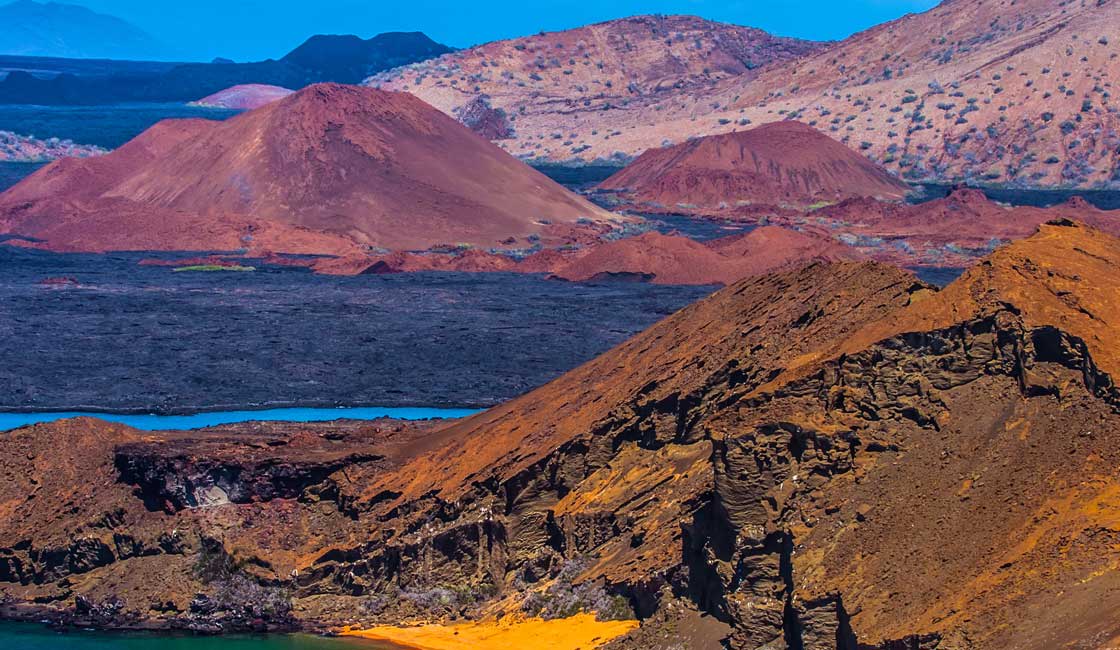
The Galapagos Landscape
Though the Galapagos archipelago is equatorial, the islands have a more moderate, drier climate than other tropical locations, so are pleasantly warm all year-round with an average temperature in the Galapagos Islands of 24 C or 75 F.
The Galapagos Islands are world-renowned for the amazing wildlife that inhabits the archipelago and countless species are found all year long. This is because many of the plants and animals that live on these islands are endemic – they are found nowhere else on Earth! There are several Galapagos wildlife species that you can find year-round, for example, the Galapagos penguin, flightless cormorant, marine and land iguanas, blue-footed booby birds, Galapagos hawks, and both types of sea lions (California & fur).
Some birds will be nesting all year round depending on the availability of food, including Masked Nazca boobies, the magnificent and great frigate birds, flightless cormorants, penguins, and greater flamingos, as well as some reptiles like the Galapagos tortoises. But whatever time you visit, something will be nesting, breeding, or visiting the islands so there is always something spectacular to watch.
The climate of these volcanic islands is largely determined by a unique positioning in-between three surrounding ocean currents, and the shifting of these currents result in the change of seasons twice a year: a warm, wet season from late December until June, and the cool, dry season from late June to December. The differences between the seasons are due to the differences in the amount of rainfall on the islands, rather than a large change in temperature. These seasons can have a considerable difference on the weather conditions, water temperatures, and wildlife you can witness, which deserve to be covered in more detail below:
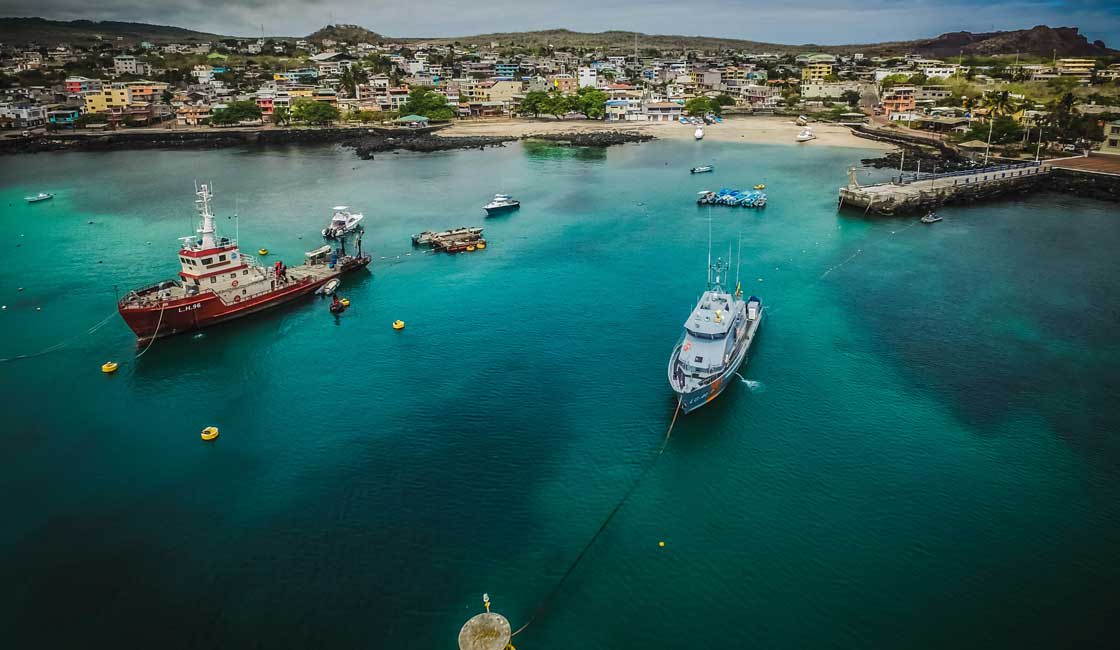
Misty day in Galapagos
During this garua (misty) season from June to December, the islands are cooled by the southern Humboldt current which brings a light, misty fog over the islands. This makes the climate cooler and drier than other months of the year. During these cool, dry months, blue skies are dotted with pleasant clouds, the sun is less intense, and the weather is not too hot.
Shorelines and islands at lower elevations receive little precipitation, though the highlands of the islands remain lush and green from quick afternoon showers. The coolest month of the year is August, with an average temperature of around 20 C or 68 F, but this is also the most humid month and can be a little sticky, so watch out for mosquitos and insects.
At this time, the water visibility is slightly lower (10m / 30ft) due to the abundance of blooming marine plankton. Despite the lower visibility, the increased food levels available to marine animals make it a great time for scuba diving and swimming with sea lion pups.
For those considering a Galapagos cruise, it should be known that the wind does pick up and waves can get choppier, which is something to bear in mind if you are susceptible to seasickness. You should expect strong surges along shores that face west or south during this season, which can make wet landings difficult for those that aren’t so agile. Indeed, lots of vessels go into dry dock for maintenance during September for this very reason.
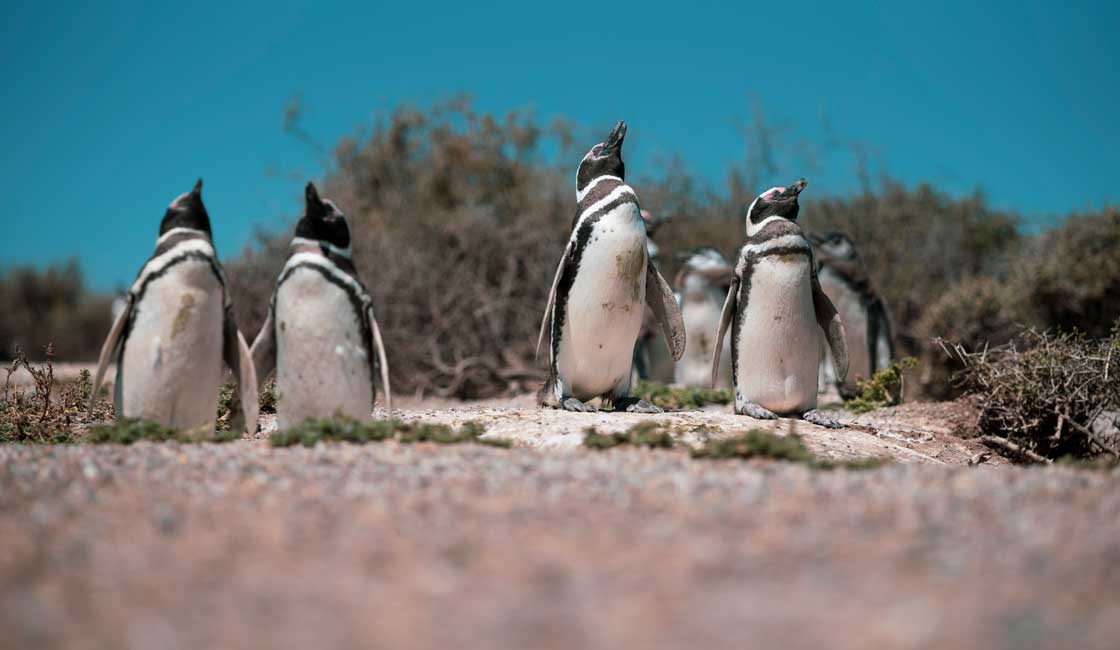
Galapagod penguins
Mid-year, the ocean currents shift and cooler waters bring nutrients to marine ecosystems, which increases food availability for animals in the Galapagos. Marine wildlife is most active during this season, including whale sharks, penguins, and mammals such as fur seals and sea lions during their pupping season. This is also when large megafauna visit the islands during their long-distance migrations to feed, especially around the western islands, making it the best time of year to observe cetaceans (whales, dolphins) in the Galapagos Islands.
Furthermore, this season is perfect for observing mating behaviors, as it is a breeding period for many animals including sea lions and fur seals, and the courtship and nesting season for birds like the Storm Petrel and Galapagos Hawk, as well as oystercatchers, lava heron, and Swallow-Tailed Gulls.
In December, the currents shift and the climate becomes more tropical, with months of warm sunny weather, thanks to the warm northern Panama current. The Northeast trade winds fall, slowing the westward current and reducing the cool upwelling. This shift in currents allows the northern Panama current to surround the island archipelago; bringing daily bursts of rain, and warmer air. The hottest months of the year are March and April, but are still enjoyable with average temperatures of around 30 C or 86 F.
Unlike wet seasons in other tropical areas, the Galapagos Islands remain surprisingly sunny, with only short, sporadic bursts of rain. As such, visitors get to experience extensive observation of both land and marine animals in their natural habitats throughout the day with little to no rain interrupting their enjoyment. During these months, the islands becoming green and lush, making for great scenic photos, especially for panoramic shots from the spectacular viewpoint on Bartolomé.
This season is a perfect time for swimming, snorkeling, and scuba diving, even without a wetsuit. The waters are calmer and underwater visibility during these months is increased, with divers being able to enjoy visibility of approximately 30m or 100ft.
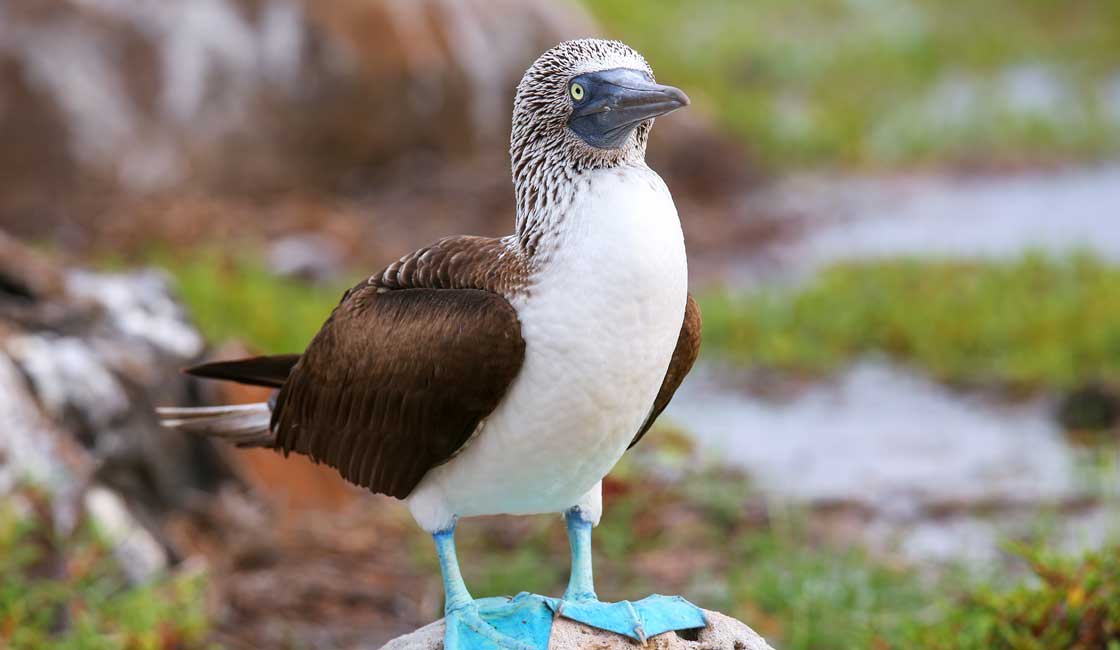
Blue footed booby
As the ocean currents shift in December, the warmer climate initiates an increase in activity for the animal residents that inhabit the Galapagos Islands; thus beginning a new season of mating, breeding and nesting. For wildlife aficionados, this season is best for observing the natural mating and nesting behaviors of many endemic species, including large migratory seabirds like the Waved Albatross, famous land birds like Red and Blue-footed Booby birds, and reptiles including both marine and land iguanas, and giant tortoises.
Both marine and land iguanas mate at the beginning of the warm season in December – January, followed by nesting during February to March. Later on in the season, the eggs begin to hatch a few months later in April or May. The famous Galapagos giant tortoise, which can grow over six feet long and weigh over 900 pounds, lays several eggs a year, but mostly during this warm season.
The green sea turtle is the largest of all turtle species, and its prime nesting season on the islands is between December and June. The turtles come to land at night to lay eggs on various sandy shorelines throughout the archipelago, their tracks and nests visible the next day. Hatching tends to happen in April and May which is a remarkable sight if you can time it right.
One of the most spectacular sights in the islands is the mass arrival of the Waved Albatross on Española at the start of April, just after the Summer Equinox. Soon after their amazing airborne courtship ritual begins and mating starts.
If you were wondering when is the best month to visit Galapagos, to provide extra granularity we have compiled a month by month calendar of the key considerations for you:
Average Temperature [ minimum – maximum ]: 22- 30 C.
Average Rainfall: 2.5cm (only in the highlands)
Average Water Temperature: 24.5 C (with great visibility)
Wildlife Highlights:
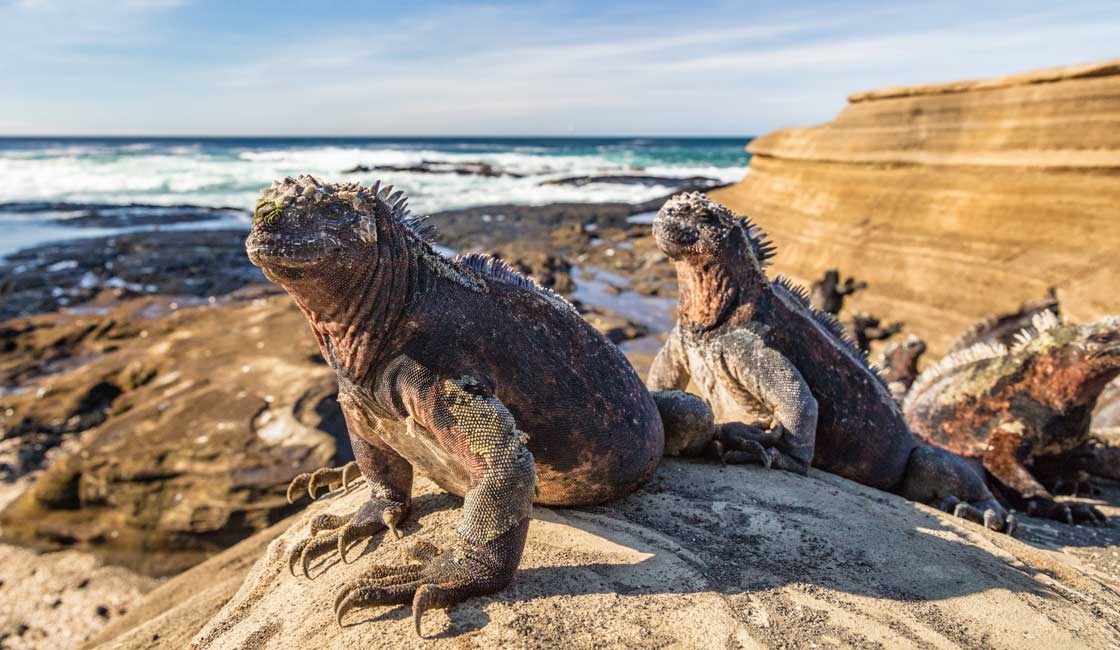
Iguanas
Average Temperature [ minimum – maximum ]: 24- 30 C
Average Rainfall: 2.5cm (in the highlands)
Average Water Temperature: 25 C (highest of year, with great visibility)
Wildlife Highlights:
Average Temperature [ minimum-maximum ]: 24- 31 C (Intense sun, high humidity, and air temperatures)
Average Rainfall: 5.1cm (peak of the rainy season in the highlands)
Average Water Temperature: 25 C (with great visibility)
Wildlife Highlights:
Average Temperature [ minimum-maximum ]: 24- 31 C
Average Rainfall: 3.8cm (in highlands)
Average Water Temperature: 25 C
Wildlife Highlights:
Average Temperature [ minimum-maximum ]: 22- 28 C
Average Rainfall: 1.9cm (in highlands)
Average Water Temperature: 24.5 C
Wildlife Highlights:

A spectacular whale
Average Temperature [ minimum-maximum ]: 21- 26 C
Average Rainfall: 0.6cm (in highlands)
Average Water Temperature: 23 C
Wildlife Highlights:
Average Temperature [ minimum-maximum ]: 20- 26 C
Average Rainfall: 1.3cm (in highlands)
Average Water Temperature: 21.5 C
Wildlife Highlights:
Average Temperature [ minimum-maximum ]: 19-26 C
Average Rainfall: 0.6cm (in highlands)
Average Water Temperature: 21.5 C
Wildlife Highlights:
Average Temperature [ minimum – maximum ]: 19-26 C
Average Rainfall: 1.3cm
Average Water Temperature: 22 C
Wildlife Highlights:
Average Temperature [ minimum – maximum ]: 20-26 C
Average Rainfall: 0.6cm (in highlands)
Average Water Temperature: 22.5 C
Wildlife Highlights:
Average Temperature [ minimum – maximum ]: 21- 26 C
Average Rainfall: 1.3cm (in highlands)
Average Water Temperature: 23 C
Wildlife Highlights:
Average Temperature [ minimum – maximum ]: 22- 27 C
Average Rainfall: 1.3cm (in highlands)
Average Water Temperature: 22.5 C
Wildlife Highlights:
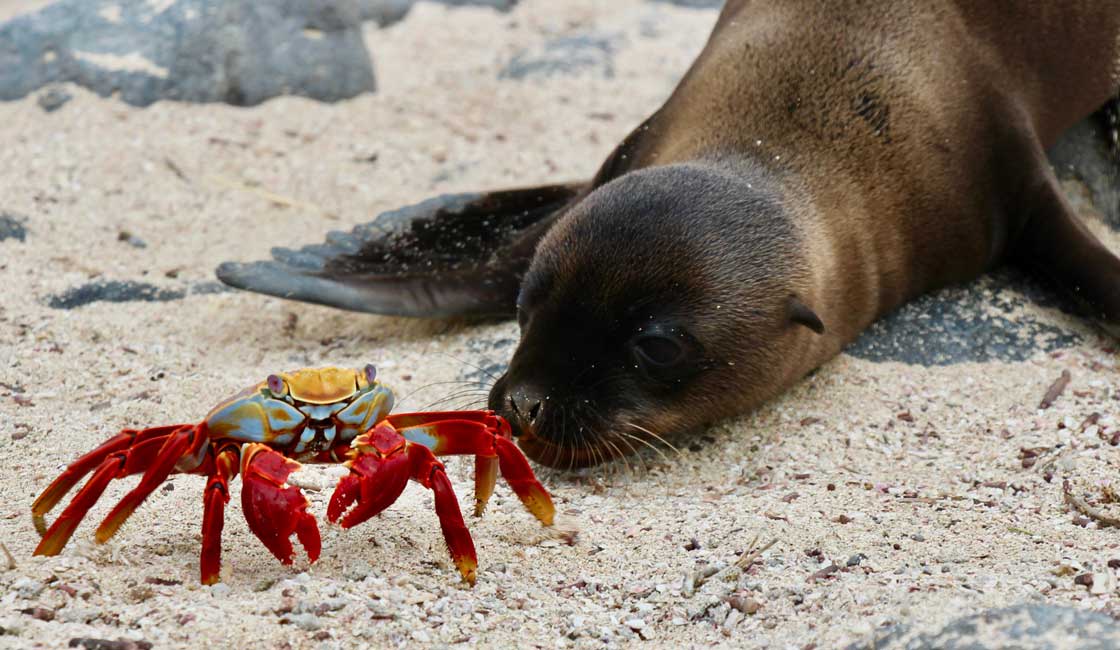
Sea lion being crab-friendly
In the Galapagos Islands, tourist traffic peaks during the summer and holiday months, when prices increase slightly and hotels and flights book up. It is important to know that during the peak season, Galapagos cruise and hotel prices are increased. The low season is generally during the months of April/May and September/October, when traffic on the island is less busy. It is highly recommended to book your Galapagos cruise several months in advance, that way you can be sure to get the flight and accommodations that work best for you.
These unique islands are rich with endemic flora and fauna all year long, so the best time to visit Galapagos very much depends on which of the considerations above are more important to you. In reality though, even if you hadn’t read this guide and done your research, you are sure to enjoy your time in Galapagos no matter when you decide to go.
While Rainforest Cruises aim to provide accurate and up-to-date information, we make no representations as to the accuracy or completeness of any information herein or found by following any link on this site. Rainforest Cruises cannot and will not accept responsibility for any omissions or inaccuracies, or for any consequences arising therefrom, including any losses, injuries, or damages resulting from the display or use of this information.




